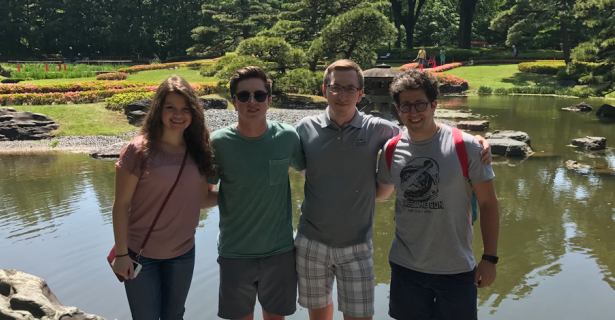This summer I had the opportunity to participate in the ALLIES Joint Research Project along with three other Tufts students – Daniel Lewis (A’20), Nicole Bardasz (A’20) and Michael Olesberg (A’19). We were accompanied by three cadets from the U.S. Military Academy and three midshipmen from the U.S. Naval Academy.
Spending three weeks in Japan, we stayed mainly in Tokyo to conduct meetings, but also visited cultural and historical sites in Kyoto and Hiroshima, such as Fushimi Inari-Taisha and the Hiroshima Peace Museum. Our purpose was, and is, to study various aspects of Japanese Civil-Military relations, with topics ranging from the Japanese Government’s rhetoric surrounding Article 9 of the Japanese Constitution to the possibility of nuclear proliferation in Japan. I am researching the influence of public opinion on Japan’s Self-Defense Force capabilities and acceptable actions, often two different discussions in Japan.
For the entire team, this trip proved to be a very enlightening, challenging, and fun experience that gave us the opportunity to begin to learn how to research a topic. Through our meetings and cultural excursions, we came away from this trip with a more informed perspective on the intricacies of Japanese society and defense policy. Through our time in Japan, we met with academics at universities such as the University of Tokyo and the National Graduate Institute of Security Studies (GRIPS), journalists at The Wall Street Journal, experts at think-tanks such as the Research Institute for Peace and Security (RIPS) and the Canon Institute for Global Studies (CIGS), diplomats at the U.S. Embassy in Tokyo and at the Japan Institute of International Affairs (JIIA), and government officials at the Ministry of Foreign Affairs and the House of Representatives.
My most memorable meeting, though, was our experience with an official at the Office of the Prime Minister of Japan. The meeting was scheduled about ten minutes after our meeting at the Ministry of Foreign Affairs, so we immediately found ourselves (a group of 11) racing through the Chiyoda and Roppongi neighborhoods of Tokyo. We passed the Ministry of Defense and then the National Diet Building. When we finally arrived at the building, the Office was underwhelming and not what we were expecting. Something felt wrong. We attempted to look for an entrance, and when we did, we were immediately confronted by a team of security guards, none of who spoke any English, and none of us spoke any Japanese. After a bit of incomprehensible negotiation by both sides, I called my contact at the Prime Minister’s office who had set up the meeting. He spoke to the guards via my cell phone, an aide was sent down for us, and we were led through security, right into a parking garage. We had arrived at the backdoor—the employee entrance.
Once through security, we convened in a conference room, in which the official with whom we were meeting had laid out Shinzo Abe promotional materials. Operation Tomadachi was front and center, and ‘Abenomics’ was on full display. This was already the most interesting meeting we had been to in Japan. As we began asking the official our questions, we realized we were going to get much more than we ever could have expected. The official, as we suspected, was very favorable towards Abe and the LDP, including its very right-wing, conservative message. The official, though, did not give us the average stump speech we had been expecting. We received stern answers to tough questions (I can’t disclose the answers in this blog post, as the official requested that he not be publicly cited). We asked about the future of the SDF, his perceptions on the Japanese people’s opinions of the military, and how the Prime Minister communicates his message on Article 9 and the SDF.
The meeting lasted roughly 90 minutes, but could have lasted well into the night. Yet in some ways it did. Following the meeting, our group had heated discussions about the topics we had just encountered. Though a bit fiery at times, especially for my liking, our discussion following that meeting was the most in-depth, thought-provoking, and perception-challenging of the trip. The answers we had gotten were distinctly of a conservative Japanese worldview, quite different from our American-centered perceptions. It was then that I realized just how important a trip like ours was. Our world views were being challenged. We were forced to think in a different mindset. This at first made many of us uncomfortable, but we were all able to grow to overcome that challenge. This ability to encounter a worldview opposite my own and truly acknowledge that view and confront it is a skill I am excited to bring back to Tufts, something I know the other students are excited to do as well.
As of now, we are all back home for the summer. We are all completing our portions of our paper for this fall. While challenging at times, the Joint Research Project has been an amazing experience and one I’ll never forget. I’ve learned to think critically about issues I’ve never before confronted, and to truly see the world from a different perspective.

